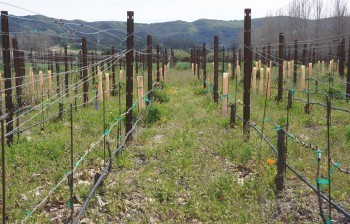The Seasons of a Vineyard
“To every thing, there is a season
And a time to every purpose under heaven:
A time to be born and a time to die: a time to plant and a time to pluck up that which is planted . . . ”
This well-known verse from Ecclesiastes applies to so much of our lives and growing grapes is no exception, especially the part about planting and plucking. There are distinct seasons for nurturing grapes and they are all crucial to the process of producing great wines.
I recently talked with Douglas Garman (best known as Dr. Doug), the Wine Educator at Europa Village Winery in the Temecula Valley Wine Country in Southern California, about what happens during each season in the Europa vineyards. I learned that while harvest time is the most celebrated wine-growing season, each season requires important steps in the process of nurturing the grapes that will lead to Europa’s outstanding wines.
At Europa, the harvest season has already begun in late July with white grapes. This is much earlier than usual because of the dry season we have been experiencing and the high sugar content in the grapes. Grapes are ripening on the vines and growing juicy and robust. Picking grapes is an exciting time in the vineyards. The red grape harvesting will probably start in mid August.
The grapes themselves actually dictate exactly when the harvest will occur. The vineyard manager and the winemaker are in constant communication when harvest time approaches. They want to harvest the grapes when they are at their peak in Brix or residual sugar content for each varietal. At Europa, harvesting almost always takes place at night when it is cooler. The vineyards are illuminated with a generator powering floodlights and work crews may harvest grapes throughout the night.
Wine Club members at Europa and other wineries sometimes have the opportunity to assist in this exciting grape picking process. But if you want to participate in the harvest be prepared to appear at the last minute late at night. You will learn the important techniques for carefully picking the grapes without bruising them.
Of course after grapes are picked, they are crushed and the process of fermenting and wine production begins. (This is another article topic coming up soon.) Meanwhile, attention must still be paid to the vines in preparation for next year’s grape growing season.
When the harvesting and crushing are over, taking care of the vineyards doesn’t stop. In the fall, a cover crop is planted between the rows of grapevines to provide stability to the soil. This cover crop is essential to nurturing the vines. Not only does it deter erosion that might occur during winter rains, it helps keep the vines healthy by attracting insects away from them. Then in the spring, the cover crop is tilled to fertilize the vines and soil.
 Although the vines may look dead, they are really just dormant as they await spring. Winter is the time for trimming shoots back, which takes place as late as possible in order to postpone bud development in the spring. The goal is for the buds to break through when there is no chance of a late frost that might destroy the grapes. Fortunately, in Temecula frost rarely comes after bud break, which typically takes place in late March. Other parts of the country are not so fortunate.
Although the vines may look dead, they are really just dormant as they await spring. Winter is the time for trimming shoots back, which takes place as late as possible in order to postpone bud development in the spring. The goal is for the buds to break through when there is no chance of a late frost that might destroy the grapes. Fortunately, in Temecula frost rarely comes after bud break, which typically takes place in late March. Other parts of the country are not so fortunate.
Temecula is blessed with an ideal terroir for growing many grape varietals. Terroir is the French word that refers to the environmental factors affecting the region—the sun, wind, soil, temperatures and elevation.
A few months after the grapes start growing in the spring, many vineyards, including Europa, actually “drop the fruit.” This involves minimizing the amount of grapes each vine is allowed to produce so that the remaining grapes will be of the highest quality. The goal at Europa is usually to have two shoots spaced apart about the distance between your thumb and forefinger when your hand is spread out. (Yes, it is hard to eliminate good grapes, but the end result is worth this drastic step.) At Europa, vines are directed to grow up and out in only one direction, usually to the left. This whole process encourages more concentrated grape flavors and, of course, more flavorful wine.
After the region’s recent dry spring and summer, many people wonder whether the grapes are getting enough water. The answer is “yes” for most wineries. At Europa, an Alcon water system throughout the vineyard monitors moisture at four different levels in the soil and can provide this information to the vineyard manager at 15-minute intervals. But the system is not on a timer because grapes do best when they are surprised at receiving water. This “surprise” approach stresses the vines and forces the roots deeper into the granite soil.
Obviously, growing great grapes is a science that Europa takes very seriously. As the seasons progress, each year is somewhat different as far as timing and how best to nurture the grapes. It’s a lot of work, but well worth the effort because of the wonderful wines that result from all this tender loving care of the vineyards.
